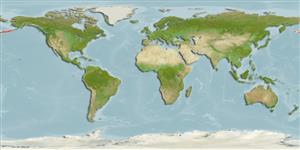>
Perciformes/Cottoidei (Sculpins) >
Liparidae (Snailfishes)
Etymology: Crystallichthys: Latin, cristallum = ice + Greek, ichthys = fish (Ref. 45335); mirabilis: Crystallichthys cameliae (Nalbant, 1965) may be a juvenile of this species (Ref. 51661).
More on authors: Jordan & Gilbert.
Environment: milieu / climate zone / depth range / distribution range
Ecología
marino demersal; rango de profundidad 53 - 830 m (Ref. 50550). Temperate
North Pacific: Kamchatka, Russia (Ref. 6876) and St. Paul Island, Alaska.
Tamaño / Peso / Age
Maturity: Lm ? range ? - ? cm
A recent reference confirming the validity of this species is needed.
Life cycle and mating behavior
Madurez | Reproducción | Puesta | Huevos | Fecundidad | Larva
Quast, J.C. and E.L. Hall, 1972. List of fishes of Alaska and adjacent waters with a guide to some of their literature. U.S. Dep. Commer., NOAA Tech. Rep. NMFS SSRF-658, 47 p. (Ref. 6876)
IUCN Red List Status (Ref. 130435: Version 2024-1)
Threat to humans
Harmless
Human uses
Herramientas
Special reports
Download XML
Fuentes de Internet
Estimates based on models
Preferred temperature (Ref.
123201): 1.1 - 4.1, mean 2.1 °C (based on 38 cells).
Phylogenetic diversity index (Ref.
82804): PD
50 = 0.6250 [Uniqueness, from 0.5 = low to 2.0 = high].
Bayesian length-weight: a=0.01622 (0.00637 - 0.04128), b=3.07 (2.84 - 3.30), in cm total length, based on LWR estimates for this (Sub)family-body shape (Ref.
93245).
Nivel trófico (Ref.
69278): 3.5 ±0.6 se; based on size and trophs of closest relatives
Resiliencia (Ref.
120179): Alto, población duplicada en un tiempo mínimo inferior a 15 meses (Preliminary K or Fecundity.).
Fishing Vulnerability (Ref.
59153): Low vulnerability (10 of 100).
